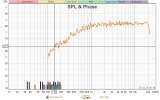So I have a project - transforming my (pretty expensive) 2 ways from passives to actives (ATC SCM20 Pro PSL Mk2), and I had the (probably wise) thought: I should probably practice on cheaper drivers... until, at least, I get very familiar with amp behaviours (like at power on) and DAC behaviours, and software behaviours (basically everything...). I don't want to scorch [especially] the tweeters!
(the amp for the tweeters will do about 60W RMS into 6 ohms before distortion begins to rise (which is about the same as the amp in the active version of those speakers), but due to their design, accidental LF tones could actually result in the dome being forcefully ejected (kinda like that 6' (foot) woofer in the guitar amp in Back to the Future), and I don't want that!!
So the woofers I have, are Dayton Audio RS150P-4A
They are cast baskets, phase plug, 150mm. They're a small 150mm, though, because of two things: first, it's small because it just is, and second, the phase plug (takes some area away in the middle) . Its surface area is 85 sq. cm, a 150mm cone would be 176 sq. cm - big difference!



Paper, Kevlar, Glass composite cone
Aluminum phase plug
Cast basket with 6 points + large openings
I believe I read somewhere there's a copper shorting ring in the motor
It's their "reference" range, for what that's worth - I think it's a pretty good woofer. I don't remember what I paid because it's been a few years now, but they were at least 100 bucks a piece. Their xmax is 4.4mm
The frequency response chart above shows this driver can be crossed at up to 4kHz (with high fidelity results) no problem. The slight impedance bump around 1.5kHz implies the driver begins becoming directional at approximately that frequency. A trick I like to do is aim to cross at about twice that - avoiding both the baffle and driver beaming
For the active practice, the crossover point can be made to be pretty much anywhere between 2kHz and 5kHz, but when I'm done messing around with active, I'd like to make it function as passive. I'm sure I'll find an exact frequency I think works best, but since I can't know that in advance, I'm looking for a tweeter that is matched (re: quality), that can be crossed easily (without a notch) second order at 3kHz. If it's 8 ohms, it needs to be at least 92dB/W so I can pad it down a little (and in case the woofer is more efficient or the tweeter is less efficient than datasheets)
Anyone have a tweeter suggestion? I don't want to spend more than $50 each, but I'm not opposed to $80 each if the value is there. I have no idea about raw drivers lately
(the amp for the tweeters will do about 60W RMS into 6 ohms before distortion begins to rise (which is about the same as the amp in the active version of those speakers), but due to their design, accidental LF tones could actually result in the dome being forcefully ejected (kinda like that 6' (foot) woofer in the guitar amp in Back to the Future), and I don't want that!!
So the woofers I have, are Dayton Audio RS150P-4A
They are cast baskets, phase plug, 150mm. They're a small 150mm, though, because of two things: first, it's small because it just is, and second, the phase plug (takes some area away in the middle) . Its surface area is 85 sq. cm, a 150mm cone would be 176 sq. cm - big difference!
Paper, Kevlar, Glass composite cone
Aluminum phase plug
Cast basket with 6 points + large openings
I believe I read somewhere there's a copper shorting ring in the motor
It's their "reference" range, for what that's worth - I think it's a pretty good woofer. I don't remember what I paid because it's been a few years now, but they were at least 100 bucks a piece. Their xmax is 4.4mm
The frequency response chart above shows this driver can be crossed at up to 4kHz (with high fidelity results) no problem. The slight impedance bump around 1.5kHz implies the driver begins becoming directional at approximately that frequency. A trick I like to do is aim to cross at about twice that - avoiding both the baffle and driver beaming
For the active practice, the crossover point can be made to be pretty much anywhere between 2kHz and 5kHz, but when I'm done messing around with active, I'd like to make it function as passive. I'm sure I'll find an exact frequency I think works best, but since I can't know that in advance, I'm looking for a tweeter that is matched (re: quality), that can be crossed easily (without a notch) second order at 3kHz. If it's 8 ohms, it needs to be at least 92dB/W so I can pad it down a little (and in case the woofer is more efficient or the tweeter is less efficient than datasheets)
Anyone have a tweeter suggestion? I don't want to spend more than $50 each, but I'm not opposed to $80 each if the value is there. I have no idea about raw drivers lately

